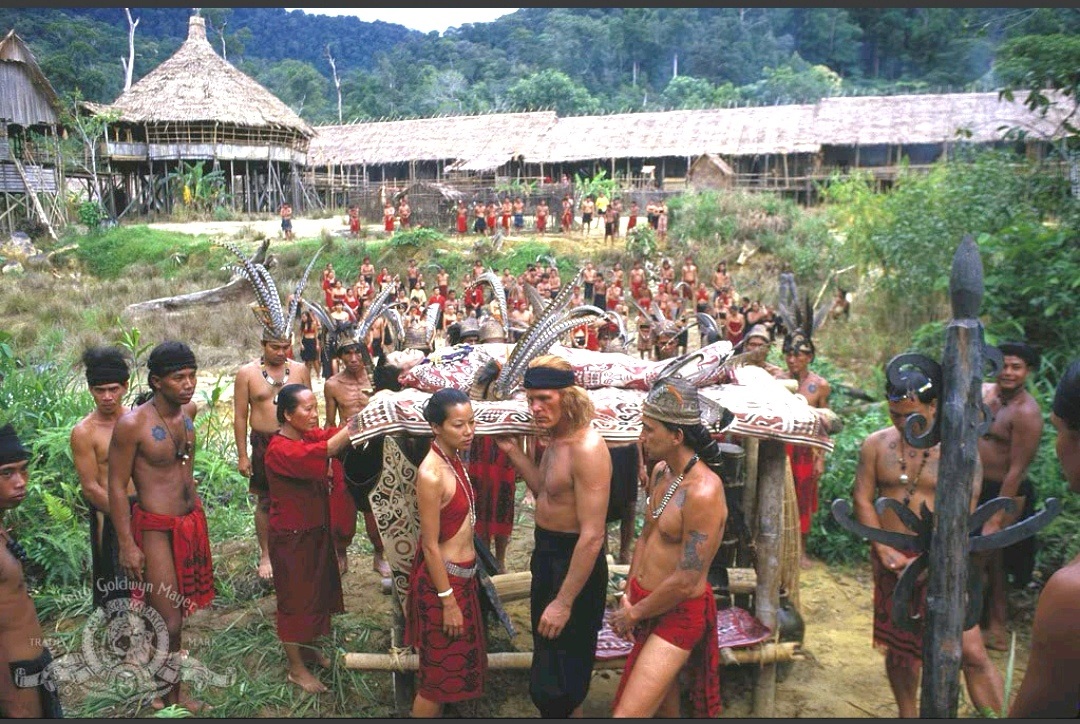
Director John Milius in front of the Matang longhouse film set of 1987’s ‘Farewell to the King’.

Edgar Ong
DURING last weekend’s speech made by the Chief Minister of Sarawak Datuk Patinggi Tan Sri Abang Johari Tun Openg at the Gabungan Parti Sarawak (GPS) election machinery launch at Parti Pesaka Bumiputera Bersatu (PBB) headquarters at Jalan Bako in Kuching, he had wistfully proclaimed his personal wish to see Sarawak ‘produce films and television shows of the same value as South Korea’s ‘Winter Sonata’ and Thailand’s ‘Love Destiny’.
Abang Jo, as he is popularly known, said he held high hopes that future films and TV series produced in Sarawak could impact the state’s tourism in the same way that the highly successful and globally popular Korean series had done for South Korea.
According to him, ‘Winter Sonata’ has, in fact, elevated the country’s name and image significantly to the point that they have a huge fan base in Japan as well.
I would continue by saying that before the Covid-19 pandemic had hit us prior to March 2020, the Korean TV series sensations (‘Winter Sonata’ was followed by many other similar Korean dramas) had singlehandedly been responsible for launching a plethora of tailor-made travel packages and tours organised by our very own local travel agencies that had successfully sold them to local fans and followers of such Korean TV series, as well as the other attractions offered by South Korea – the myriad tourist attractions, resorts, food tours and other seasonal offers.
I had my own humble beginning in the local film industry when I became a personal assistant to Ralph Marshall of Jemima Films, which belonged to Gopala Krishnan, the pioneering film producing brother of Malaysian billionaire Ananda Krishnan. This was in March 1987 and it was the start of my very long career in films. We had started with an international feature film from Hollywood, from Orion Pictures, with a film produced by famed Bruce Lee-linked producer Andre Morgan and ‘Godfather’-linked co-producer Al Ruddy.
The director was John Milius, who had successfully co-scripted ‘Apocalpyse Now’ and had come off super-hit ‘Conan the Barbarian’; the star was Nick Nolte, who in 1992 was named the ‘World’s Sexiest Man Alive’ by People Magazine!
Yes – humble beginnings indeed! It has taken me a great many years to learn what makes the industry tick, and I’m still learning the ropes today.
I remember organising the entire film crew of cast and stars to attend a grand welcoming dinner at the private mansion of then-chief minister, now our TYT Tun Pehin Sri Abdul Taib Mahmud, in Petra Jaya, with the entire list of the ‘who’s who’ from the government sector and private sector VVIPs.
There were many visits too by numerous dignitaries to our film sets during shooting and requests for meetings with the stars. We had to have tight security at and around our main film set, which was at the foothill of Gunong Serapi, and the road to Matang and the surrounding areas were often blockaded for our filming.
The biggest logistical nightmares were the scenes shot in and around the busy town areas, especially on the grounds of the old Sarawak Museum, the Chung Hua Primary School No 1 at Park Lane, the hanging scene at Fort Margherita, the Japanese battle bridge scene at Taman Malihah in Matang, the prisoner scene at the oyster culture research farm, and others.
As the film itself was a period piece, we had to build and construct all of our film sets from scratch and these locations were scouted for and found outside of Kuching city. The main set for the longhouse and the ‘baruk’ were built at the foothill of Mount Serapi and took us over four months; it had collapsed earlier on due to a freak thunderstorm and extreme rainfall, and had to be rebuilt a second time.
We also encountered many labour problems, especially from the local crew and had a number of accidents on set. It was a nightmare bringing in film crew from all over the world, actors from the USA, Europe, Australia, stuntmen from Hong Kong and Kuala Lumpur, craftsmen and artisans from Sri Lanka and India, and even a world-famous actor whose passport was not accepted by Malaysia!
The Armed Forces and Royal Malaysia Police (PDRM) had greatly assisted us with all the importation and re-export of the armoury, artillery and explosives – both real and fake.
Eventually upon completion of filming at the end of 1987, the entire longhouse set was gifted and handed over to the Sarawak Boys Scouts, who had wanted it for their future promotional purposes. The original thinking was that if the film were to strike it big and become successful worldwide, it would create a demand for film lovers and tourists to come and visit the original film set in the future.

A crowd scene with Nick Nolte and cast of extras on the entire compound main set, now the Boys Scouts headquarters, since left to waste.
The famous film set as tourist attraction gimmick first started after the film ‘Bridge on the River Kwai’ had won the Oscar in 1958 for ‘Best Picture’. The location for the ‘reel’ bridge was in Kitulgala, Sri Lanka, which is 60km south-west from Kandy, and tourists started to make a beeline to the location just to view the famous bridge!
However, the real bridge is still standing today at Kanchanaburi, Thailand – standing majestically on the edge of the Thai jungle!
So you can say that both countries have benefitted from the aftermath of ‘River Kwai’!
A small footnote on bridges – we did build two bridges for the movie ‘Farewell to the King; one, a short bamboo bridge across the ‘Ang Kio’ (Red Bridge) stream at Matang; and a much longer and more solid one across the river at Malihah, also in Matang.
The bamboo one was ‘machetéd’ down by Nolte in the movie, and the Malihah bridge was blown up (with real explosives) by the British Forces with Japanese soldiers falling off from it.
Back to our Chief Minister’s recent wish – yes, we do have the talents locally to be able, in theory, to produce, create and indeed make a success of our still-in-its-infancy film industry.
I know that we have the creative minds – from the writers to the animators, from the camera, sound, lighting, to the other crews – many of whom right now can’t find enough work here so are now working elsewhere, mainly on the mainland.
We need to improve and upgrade whatever available facilities that we have – our studios for larger film sets, and if the government is willing to lend a supportive ear to the industry and listen to their many suggestions, proposals and of course grouses, we can get off to a great start of a beautiful relationship.
The immediate issue I know of and can amplify on behalf of the industry is that it is virtually impossible to source financing – there are no revolving funds available, nor are there financial institutions, commercial entities or other private investors who are interested to plough in their money to invest in a commercial film or TV series.
Until and unless the government, through one of its agencies, can set up its own government-linked unit to help and assist the current group of filmmakers and the creative pool of talents who are still working within Sarawak, I cannot see the film industry growing at all.
We can neither depend on just the National Film Development Corporation of Malaysia (Finas), nor any other federally-constituted agencies – we have to look after ourselves.
I sincerely hope that one day in the not too distant future, our dear CM, Abang Jo, could indeed stand up at the rostrum in a darkened cinema somewhere in Kuching and announce the world premiere of a full-length feature film or mini-series, which was fully produced in Sarawak – a feat that we could all be proud of.
Something truthfully ‘Made in Sarawak’! Let’s show to the world that we can!
